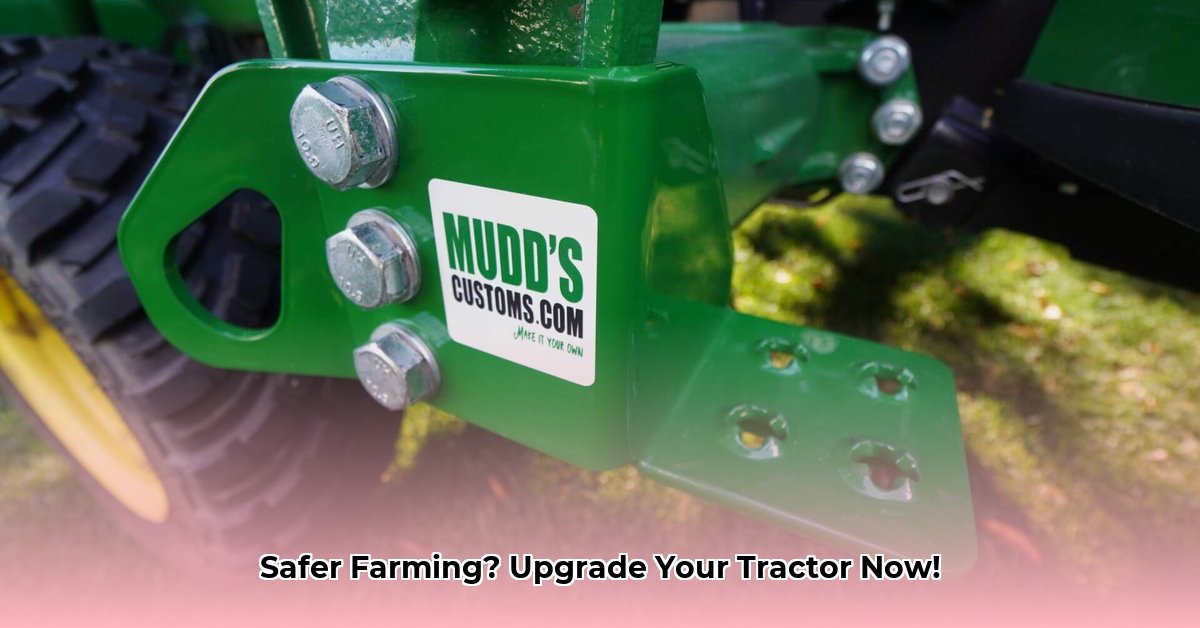
Aftermarket Tractor Steps: A Farmer's Guide to Enhanced Safety and Efficiency
Climbing onto a tractor shouldn't be a risky maneuver. Yet, for many farmers, it's a daily hazard. Inadequate tractor access contributes significantly to on-farm accidents, resulting in serious injuries and costly downtime. This isn't just about minor scrapes; we're talking about potentially life-altering events that impact both the farmer and the farm's productivity. Upgrading your tractor with robust aftermarket steps is a crucial investment – a commitment to your well-being and the long-term health of your operation. This guide will equip you with the knowledge to select, install, and maintain these essential safety components. For more on tractor safety, check out this resource on ROPS.
Did you know that a recent study by the National Institute for Occupational Safety and Health (NIOSH) showed a 25% reduction in tractor-related injuries on farms that implemented improved access points? This emphasizes that a small investment in safety can yield significant returns.
Choosing the Right Aftermarket Tractor Steps: Finding the Perfect Fit
The market offers a vast array of aftermarket tractor steps, each catering to different needs and preferences. Selecting the right ones depends on factors such as your specific tractor model, budget, and individual requirements. Let's dissect your options:
1. Universal vs. Model-Specific: Universal steps (designed to fit various tractor models) offer affordability and accessibility but might compromise the perfect fit. Model-specific steps (custom-designed for your tractor) provide superior integration and safety, but generally cost more.
2. Material Matters: Steel steps are known for their durability but are susceptible to rust, especially in humid environments. Aluminum steps, while often more expensive, are lighter, more corrosion-resistant, and easier to maintain.
3. Safety-Enhancing Features: Anti-slip surfaces are crucial for preventing falls, especially in wet conditions. Sturdy handrails provide additional support and stability. Step height and design should accommodate your individual physical characteristics for safe and comfortable use.
| Step Type | Pros | Cons | Estimated Cost Range |
|---|---|---|---|
| Universal Steel Steps | Durable, relatively inexpensive, widely available | Prone to rust, may not provide a perfect fit, can be heavier | $50 - $250 |
| Model-Specific Steel Steps | Secure, integrated fit, often more aesthetically pleasing | More expensive, less adaptable to different tractors | $100 - $500 |
| Universal Aluminum Steps | Lightweight, corrosion-resistant, generally easier to clean | Can dent, potentially more expensive than steel for comparable quality | $150 - $400 |
| Model-Specific Aluminum Steps | Best fit, lightweight, long-lasting, corrosion-resistant | Highest price point, least adaptable | $250 - $600+ |
Installation: A Step-by-Step Guide (Prioritizing Safety)
Installation methods vary slightly depending on your choice of steps. Always consult the manufacturer's instructions for detailed guidance. Remember: safety is paramount throughout the entire process.
Step 1: Thorough Preparation: Begin by meticulously cleaning the tractor's mounting area, removing all dirt, debris, and rust. Gather all necessary tools (wrenches, bolts, potentially a power drill).
Step 2: Accurate Placement: Carefully align the steps with the designated mounting points on your tractor. Precise placement is critical for stability and safety; a poorly aligned installation compromises both.
Step 3: Secure Fastening: Adhere strictly to the manufacturer's instructions when tightening bolts. Use the correct torque settings to avoid damage to the tractor or the steps.
Step 4: Meticulous Inspection: Following installation, thoroughly inspect the steps. Test their stability by gently rocking them; any wobbling demands immediate attention. If in doubt consult a qualified mechanic.
Safety Precautions: A Proactive Approach
Safety isn't a one-time event; it's an ongoing commitment. Follow these guidelines:
Before Installation: Always disconnect the tractor's power source before commencing work.
During Installation: Wear appropriate personal protective equipment (PPE), including gloves and safety glasses.
After Installation: Conduct a comprehensive post-installation inspection, verifying the tightness of all bolts and the overall security of the steps.
Maintenance and Longevity: Ensuring Continued Safety
Regular maintenance extends your steps' lifespan and reinforces their safety. Inspect them frequently for signs of damage, wear, or loose bolts. Clean them periodically to prevent corrosion and preserve their anti-slip properties. Replace any damaged components immediately. Preventative maintenance minimizes the risk of costly repairs or serious accidents.
The Investment in Safety: A Cost-Benefit Analysis
While the initial investment in aftermarket steps might seem significant, the long-term benefits are substantial. Avoid costly medical bills, lost workdays, and increased insurance premiums. A safer workplace leads to improved morale and productivity. Investing in safety contributes to the long-term success and sustainability of your farm.
Finding Reputable Suppliers: Your Path to Quality Products
Many suppliers offer high-quality aftermarket tractor steps. Thoroughly research your options, consulting your local farm equipment dealerships or exploring online retailers. Carefully assess their reputation and customer reviews. Ensure the products you choose meet all applicable safety standards.
Investing in high-quality aftermarket tractor steps is more than an upgrade; it's a crucial investment in your safety, well-being, and the future success of your farm. Don't let a seemingly minor detail become a major hazard. Prioritize your safety and enjoy a more secure and productive farming experience.